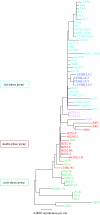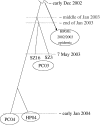SARS molecular epidemiology: a Chinese fairy tale of controlling an emerging zoonotic disease in the genomics era
- PMID: 17327210
- PMCID: PMC2435571
- DOI: 10.1098/rstb.2007.2034
SARS molecular epidemiology: a Chinese fairy tale of controlling an emerging zoonotic disease in the genomics era
Abstract
Severe acute respiratory syndrome (SARS) was the first natural disaster that challenged the Chinese people at the beginning of the twenty-first century. It was caused by a novel animal coronavirus, never recognized or characterized before. This SARS coronavirus (SARS-CoV) exploited opportunities provided by 'wet markets' in southern China to adapt to the palm civet and human. Under the positive selection pressure of human host, certain mutated lineages of the virus became readily transmissible between humans and thus caused the epidemic of 2002-2003. This review will provide first-hand information, particularly from Guangdong, China, about the initial epidemiology, the identification of the aetiological agent of the disease, the molecular evolution study of the virus, the finding of SARS-like CoV in horseshoe bats and the mechanistic analysis for the cross-host tropism transition. The substantial scientific contributions made by the Chinese scientists towards understanding the virus and the disease will be emphasized. Along with the description of the scientific discoveries and analyses, the significant impact of these researches upon the public health measurement or regulations will be highlighted. It is aimed to appreciate the concerted and coordinated global response that controlled SARS within a short period of time as well as the research strategy and methodology developed along with this process, which can be applied in response to other public health challenges, particularly the future emerging/re-merging infectious diseases.
Figures








References
-
- Anderson R.M, Fraser C, Ghani A.C, Donnelly C.A, Riley S, Ferguson N.M, Leung G.M, Lam T.H, Hedley A.J. Epidemiology, transmission dynamics and control of SARS: the 2002–2003 epidemic. Phil. Trans. R. Soc. B. 2004;359:1091–1105. doi:10.1098/rstb.2004.1490 - DOI - PMC - PubMed
-
- Babcock G.J, Esshaki D.J, Thomas W.D, Jr, Ambrosino D.M. Amino acids 270 to 510 of the severe acute respiratory syndrome coronavirus spike protein are required for interaction with receptor. J. Virol. 2004;78:4552–4560. doi:10.1128/JVI.78.9.4552-4560.2004 - DOI - PMC - PubMed
-
- Bartlam M, Yang H, Rao Z. Structural insights into SARS coronavirus proteins. Curr. Opin. Struct. Biol. 2005;15:664–672. doi:10.1016/j.sbi.2005.10.004 - DOI - PMC - PubMed
-
- Bernini A, et al. Prediction of quaternary assembly of SARS coronavirus peplomer. Biochem. Biophys. Res. Commun. 2004;325:1210–1214. doi:10.1016/j.bbrc.2004.10.156 - DOI - PMC - PubMed
Publication types
MeSH terms
LinkOut - more resources
Full Text Sources
Medical
Miscellaneous
